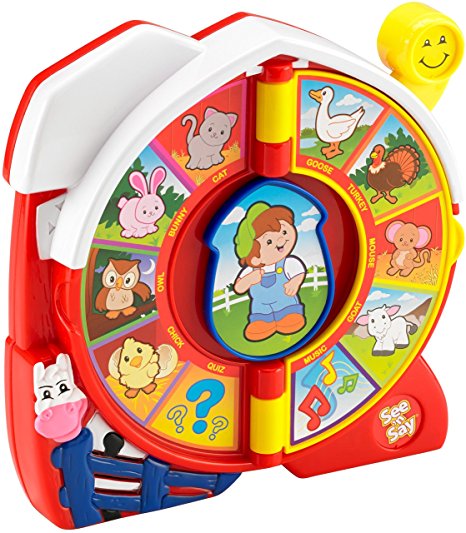10.6. Polymorphism¶
Polymorphism is a big word that you can break down into “poly” which means many and “morphism” which means form. So, it just means many forms. In Java it means that the method that gets called at run-time (when the code is run) depends on the type of the object at run-time.
This is simliar to a toddler toy that has pictures of animals and when a handle is pulled an arrow spins. When the arrow stops the toy plays the sound associated with that animal.

Figure 1: A see n say toy¶
If you were simulating this toy in software you could create an Animal class that had a makeNoise method. Each subclass of Animal would override the makeNoise method to make the correct noise for that type. This type of polymorphism is called inheritance-based polymorphism. You have a common parent class, but the behavior is specified in the child class.
Note
In Java an object variable has both a declared (compile-time) type and an actual (run-time) type. The declared (compile-time) type of a variable is the type that is used in the declaration. The actual (run-time) type is the class that actually creates the object using new.
The variable nameList declared below has a declared type of List and an actual or run-time type of ArrayList. The complier will check if the declared type has the methods or inherits the methods being used in the code and give an error if it doesn’t find the method(s). The List interface does have an add method so this code will compile. At run-time the execution environment will first look for the add method in the ArrayList class since that is the actual or run-time type. If it doesn’t find it there it will look in the parent class and keep looking up the inheritance tree until it finds the method. It may go up all the way to the Object class. The method will be found, since otherwise the code would not have compiled.
List<String> nameList = new ArrayList<String>();
nameList.add("Hi");
The variable message declared below has a declared type of Object and an actual or run-time type of String. Since the declared type of message is Object the code message.indexOf("h"); will cause a compiler error since the Object class does not have an indexOf method.
Object message = new String("hi");
message.indexOf("h"); // ERROR!! Objects don't have indexOf!
At compile time, the compiler uses the declared type to check that the methods you are trying to use are available to an object of that type. The code won’t compile if the methods don’t exist in that class or some parent class of that class. At run-time, the actual method that is called depends on the actual type of the object. Remember that an object keeps a reference to the class that created it (an object of the class called Class). When a method is called at run-time the first place that is checked for that method is the class that created the object. If the method is found there it will be executed. If not, the parent of that class will be checked and so on until the method is found.
In the last lesson on inheritance hierarchies, we were actually seeing polymorphic behavior at run-time in the following ways.
Polymorphic assignment statements such as
Shape s = new Rectangle();Polymorphic parameters such as
print(Shape)being called with different subclass types.Polymorphic array and ArrayList types such as
Shape[] shapeArray = { new Rectangle(), new Square() };
In all of these cases, there are no errors at compile-time because the compiler checks that the “subclass is-a superclass” relationship is true. But at run-time, the Java interpreter will use the object’s actual subclass type and call the subclass methods for any overriden methods. This is why they are polymorphic – the same code can have different results depending on the object’s actual type at run-time.
- Shape Shape Shape Shape
- The Rectangle subclass of Shape overrides the what method so this can't be right.
- Shape Rectangle Square Circle
- The Square subclass doesn't not override the what method so it will use the one in Rectangle.
- There will be a compile time error
- This code will compile. The declared type can hold objects of that type or any subclass of the type.
- Shape Rectangle Rectangle Circle
- The Shape object will print Shape. The Rectangle object will print Rectangle. The Square object will also print Rectangle since it doesn't overrride the what method. The Circle object will print Circle.
- Shape Rectangle Rectangle Oval
- The Circle class does override the what method so this can't be right.
10-6-1: What is the output from running the main method in the Shape class?
public class Shape {
public void what() { System.out.print("Shape ");}
public static void main(String[] args) {
Shape[] shapes = {new Shape(), new Rectangle(), new Square(),
new Circle()};
for (Shape s : shapes)
{
s.what();
System.out.print(" ");
}
}
}
class Rectangle extends Shape {
public void what() { System.out.print("Rectangle "); }
}
class Square extends Rectangle {
}
class Oval extends Shape {
public void what() { System.out.print("Oval "); }
}
class Circle extends Oval {
public void what() { System.out.print("Circle ");}
}
You can step through this code using the Java Visualizer by clicking on the following link Shape Example.
- Pizza
- This would be true if s1 was actually a Student, but it is a GradStudent. Remember that the run-time will look for the method first in the class that created the object.
- Taco
- Even though the getInfo method is in Student when getFood is called the run-time will look for that method first in the class that created this object which in this case is the GradStudent class.
- You will get a compile time error
- This code will compile. The student class does have a getInfo method.
- You will get a run-time error
- There is no problem at run-time.
10-6-2: What is the output from running the main method in the Student class?
public class Student {
public String getFood() {
return "Pizza";
}
public String getInfo() {
return this.getFood();
}
public static void main(String[] args)
{
Student s1 = new GradStudent();
s1.getInfo();
}
}
class GradStudent extends Student {
public String getFood() {
return "Taco";
}
}
You can step through this code using the Java Visualizer by clicking on the following link Student Example.
- 5 6 10 11
- The code compiles correctly, and because RaceCar extends the Car class, all the public object methods of Car can be used by RaceCar objects.
- 5 6 5 6
- RaceCar, while it inherits object methods from Car via inheritance, has a separate and different constructor that sets the initial fuel amount to 2 * g, thus in this case, fuel for fastCar is set to 10 initially.
- 10 11 10 11
- The variable car is a Car object, so the constructor used is not the same as the fastCar object which is a RaceCar. The car constructor does not change the passed in parameter, so it is set to 5 initially.
- The code won't compile.
- RaceCar inherits from the Car class so all the public object methods in Car can be accessed by any object of the RaceCar class.
10-6-3: What is the output from running the main method in the RaceCar class?
public class Car
{
private int fuel;
public Car() { fuel = 0; }
public Car(int g) { fuel = g; }
public void addFuel() { fuel++; }
public void display() { System.out.print(fuel + " "); }
public static void main(String[] args)
{
Car car = new Car(5);
Car fastCar = new RaceCar(5);
car.display();
car.addFuel();
car.display();
fastCar.display();
fastCar.addFuel();
fastCar.display();
}
}
class RaceCar extends Car
{
public RaceCar(int g) { super(2*g); }
}
You can step through the code using the Java Visualizer by clicking on the following link: Car Example.
- b.getISBN();
- The b object is actually a Dictionary object which inherits the getISBN method from Book.
- b.getDefintion();
- At compile time the declared type is Book and the Book class does not have or inherit a getDefintion method.
- ((Dictionary) b).getDefinition();
- Casting to Dictionary means that the compiler will check the Dictionary class for the getDefinition method.
10-6-4: Given the following class definitions and a declaration of Book b = new Dictionary which of the following will cause a compile-time error?
public class Book
{
public String getISBN()
{
// implementation not shown
}
// constructors, fields, and other methods not shown
}
public class Dictionary extends Book
{
public String getDefinition()
{
// implementation not shown
}
}
10.6.1.  Programming Challenge : Shopping Cart 2¶
Programming Challenge : Shopping Cart 2¶

In the last lesson, you created a class called DiscountedItem as part of a Shopping Cart application. Please copy your solutions from the last lesson into the Active Code window below (or in repl or another IDE) before completing this challenge.
The ShoppingCart contains a polymorphic ArrayList called order that you can use to add Items or DiscountedItems to the shopping cart. The Item class keeps track of the name and the price of each Item. The DiscountedItem class you wrote in the last lesson adds on a discount amount.
In this challenge, you will write a method called int countDiscountedItems() in the ShoppingCart class.
This method will use a loop to traverse the ArrayList of Items called order.
In the loop, you will test if each Item is a DiscountedItem by using the
instanceofkeyword ((object instanceof Class) returns true or false) similar to its use in the add(Item) method.If it is a DiscountedItem, then you will count it.
At the end of the loop, the method will return the count.
Make sure you print out the number of discounted items in the main method or in printOrder(), so that you can test your method. Add more items to the order to test it.
Copy in your code for DiscountedItem below and then write a method called countDiscountedItems which traverses the polymorphic ArrayLists of Items. Use instanceOf to test items to see see if they are a DiscountedItem.
10.6.2. Summary¶
At compile time, methods in or inherited by the declared type determine the correctness of a non-static method call.
At run-time, the method in the actual object type is executed for a non-static method call. This is called polymorphism.
